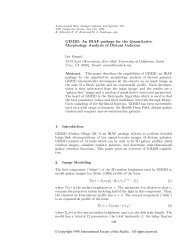4 Comparison of the ALMA and Herschel - ESO
4 Comparison of the ALMA and Herschel - ESO
4 Comparison of the ALMA and Herschel - ESO
You also want an ePaper? Increase the reach of your titles
YUMPU automatically turns print PDFs into web optimized ePapers that Google loves.
Figure 11: This plot shows <strong>the</strong> coverage <strong>of</strong> redshift versus <strong>the</strong> rotational quantum number J for carbon<br />
monoxide transitions for <strong>the</strong> receivers delivered in <strong>the</strong> North America <strong>ESO</strong> agreement. This illustrates <strong>the</strong><br />
possibility <strong>of</strong> measuring <strong>the</strong> redshift <strong>of</strong> molecular content <strong>of</strong> a source detected only in dust continuum.<br />
The colour coding identifies <strong>the</strong> <strong>ALMA</strong> “first light” receiver b<strong>and</strong>s (provided by C. de Breuck).<br />
In one scenario PACS <strong>and</strong> SPIRE measurements provide sources for <strong>ALMA</strong> follow-up<br />
studies. An alternative is described in <strong>the</strong> DRSP below, in which <strong>ALMA</strong> is used to make a<br />
very deep unbiased survey.<br />
In DRSP 1 contribution 1.1.1, Unbiased survey <strong>of</strong> sub-mm galaxies, Part 1, it is proposed to<br />
carry out an unbiased broadb<strong>and</strong> continuum survey <strong>of</strong> a 4’ by 4’ region at 290 GHz. The continuum<br />
noise limit is 24 µJy. At 290 GHz, each <strong>ALMA</strong> antenna has a full width to half power<br />
(FWHP) <strong>of</strong> 21”. To fully sample <strong>the</strong> region, one must space pointing positions by a FWHP.<br />
This requires 132 pointings. To reach <strong>the</strong> rms noise, one must integrate at each position for 30<br />
minutes. The total time is 80 hours; this time includes <strong>the</strong> measurement <strong>of</strong> reference positions<br />
<strong>and</strong> calibrations. One could increase <strong>the</strong> value <strong>of</strong> such a survey by choosing a region such as<br />
<strong>the</strong> Hubble Deep Field South, or a GOODS region.<br />
A follow-up contribution is a combined spectral line <strong>and</strong> continuum survey, in DRSP programme<br />
1.1.2 Unbiased survey <strong>of</strong> sub-mm galaxies, Part 2. This is to be carried out at 3<br />
mm, with an angular resolution <strong>of</strong> 3”. The FWHP beam <strong>of</strong> each antenna is 1’, so continuum<br />
measurements <strong>of</strong> a 4’ by 4’ region require 16 pointings. The time needed is 4 hours per position<br />
to reach an RMS noise limit <strong>of</strong> 1.5 µJy. The spectral line survey is to be carried out using<br />
4 separate settings. Each setting is spaced by 8 GHz, <strong>the</strong> velocity resolution is 50 kms -1 , or<br />
16.65 MHz at 100 GHz. To reach <strong>the</strong> rms noise limit <strong>of</strong> 40 µJy, one must integrate 4 hours at<br />
each position, for a total time <strong>of</strong> 64 hours.<br />
1 The boxed text here <strong>and</strong> in <strong>the</strong> following sections are excerpts from <strong>the</strong> <strong>ALMA</strong> Design Reference Science<br />
Plan describing proposed science applications for <strong>ALMA</strong>.<br />
26




